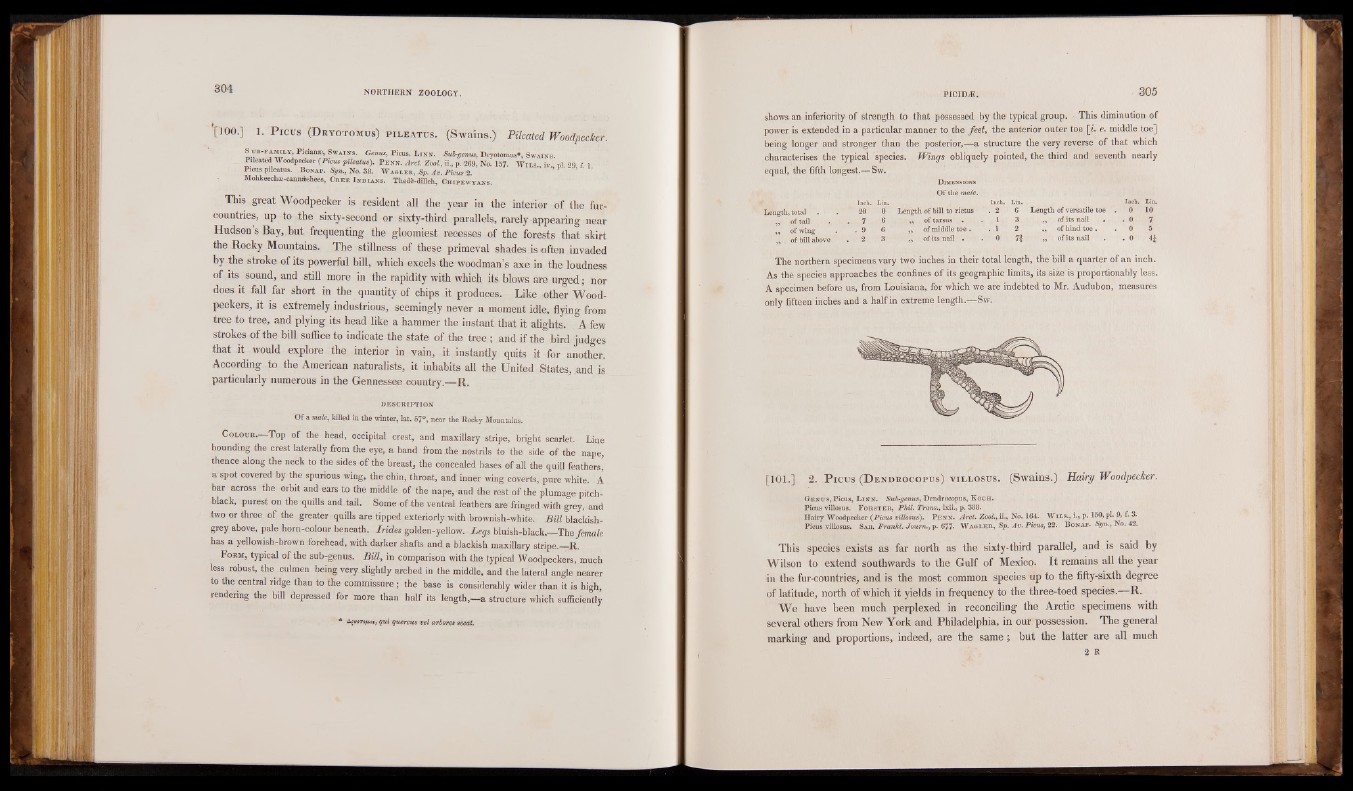
[100.] 1. Prcus (D r y o t o m u s ) p il e a t u s . (Swains,) PUeated Woodpecker.
S u b -f a m il y , Picians, Sw a in s . Genus, Picus, L in k . Sub-genus, Dryotomus*, Sw a in s.
Pueated Woodpecker (Picus pileatus). P e sn . Arct. Zot>l.,ti., p.269, No. 157. W lL s.,iv'p l 29 f 1 Picus .pileatus. B ohap. Sgn,, No. 88. W a g l e r , Sp. Av. Pious '2.
Molikeechse-cann&shees, Cr e e I n d ia y s . ThedMilleh, Ch ip ew y a k s .
This great Woodpecker is resident all the year in the interior of the fur-
countries, up to the sixty-second or sixty-third parallels, rarely appearing near
Hudson’s Bay, but frequenting the gloomiest recesses of the forests that skirt
the Rocky Mountains. The stillness of these primeval shades is often invaded
by the stroke of its powerful bill, which excels the woodman’s axe in the loudness
of its sound, and still more in the rapidity with which its blows are urged; nor
does it fall far short in the quantity of chips it produces. Like other Woodpeckers,
it is extremely industrious, seemingly never a moment idle, flying from
tree to tree, and plying its head like a hammer the instant that it alights. A few
strokes of the bill suffice to indicate the state of the tree ; and if the bird j udges
that it would explore the interior in vain, it instantly quits it for another.
According to the American naturalists, it inhabits all the United States, .and is particularly numerous in the Gennessee country.—R.
DESCRIPTION
Of a male, killed in the winter, lat. 57°, near the Rocky Mountains.
Colour. Top of the head, occipital crest, and maxillary stripe, bright scarlet. Line
bounding the crest laterally from the eye, a band from the nostrils to the side of the nape,
thence along the neck to the sides of the breast, the concealed bases of all the quill feathers,
a spot covered by the spurious wing, the chin, throat, and inner wing coverts, pure white. A
bar across the orbit and ears to-the middle of the nape, and the rest of the plumage pitch-
black, purest on the quills and -tail. Some of the ventral feathers are fringed with grey, and
two or three of the greater-quills are tipped exteriorly with brownish-white. Bill blackish-
grey above, pale horn-colour beneath. Irides golden-yellow. Legs bluish-black.—1The female
has a yellowish-brown forehead, with darker shafts and a blackish maxillary stripe.—R.
Form, typical of the sub-genus. Bill, in comparison with the typical Woodpeckers, ,much
less robust, the culmen being very slightly arched in the middle, and the literal angle nearer
to the central ridge than to the commissure j the base is considerably wider than it is high,
rendering the bill depressed for more than half its length,—a structure which sufficiently
* A^voro/ios, qui quercus vel arbores secat.
shows an inferiority of strength to that possessed by the typical group. This diminution of
power is extended in a particular manner to the feet, the anterior outer toe [i. e. middle toe]
being longer and stronger than the posterior,—a structure the very reverse of that which
characterises the typical species. Wings obliquely pointed, the third and seventh nearly
equal, the fifth longest.—Sw.
Dimensions
Of the male.
Length, total 20 0 Length of bill to rictus
Inch. Lin. .
. 2 6 Length of versatile toe .. 0 10
of tail . 7 6 ; ■ „ . of tarsus , . 1 3 • , of its nail . • . 0 7
>, of wing . . 9 6 ,, of middle toe . . 1 2 ' of hind toe . . o' 5
. of bill above . 2 3 ,, of its nail . . 0 7 | „ of its nail . 0 4*
The northern specimens vary two inches in their total length, the bill a quarter of an inch.
As the species approaches the confines of its geographic limits, its size is proportionably less.
A specimen before us, from Louisiana, for which we are indebted to Mr. Audubon, measures
only fifteen inches and a half in extreme length.—Sw.
[101.] 2. Picus ( D e n d r o c o p u s ) v il l o s u s . (Swains.) Hairy Woodpecker.
Ge n u s , Picus, L in n . Sub-genus, Dendrocopus, K o ch.
Picus villosus. F o r s t e r , Phil. Trans., lxii., p. 388.
Hairy Woodpecker (Picus villosus'). P e n n . Aret. Zool., ii., No. 164. Wils., i., p. 150, pi. 9, f. 3.
Picus villosus. Sab. Frankl. Joum., p. 677» W a g l e r , Sp. Av. Picus, 22. B on ap. Sgn., No. 42.
This species exists as far north as the sixty-third parallel, and is said by
Wilson to extend southwards to the Gulf of Mexico. It remains all the year
in the fur-countries, and is the most common species up to the fifty-sixth degree
of latitude, north of which it yields in frequency to the three-toed species.—R.
We have been much perplexed in reconciling the Arctic specimens with
several others from New York and Philadelphia, in our possession. The general
marking and proportions, indeed, are the same; but the latter are all much